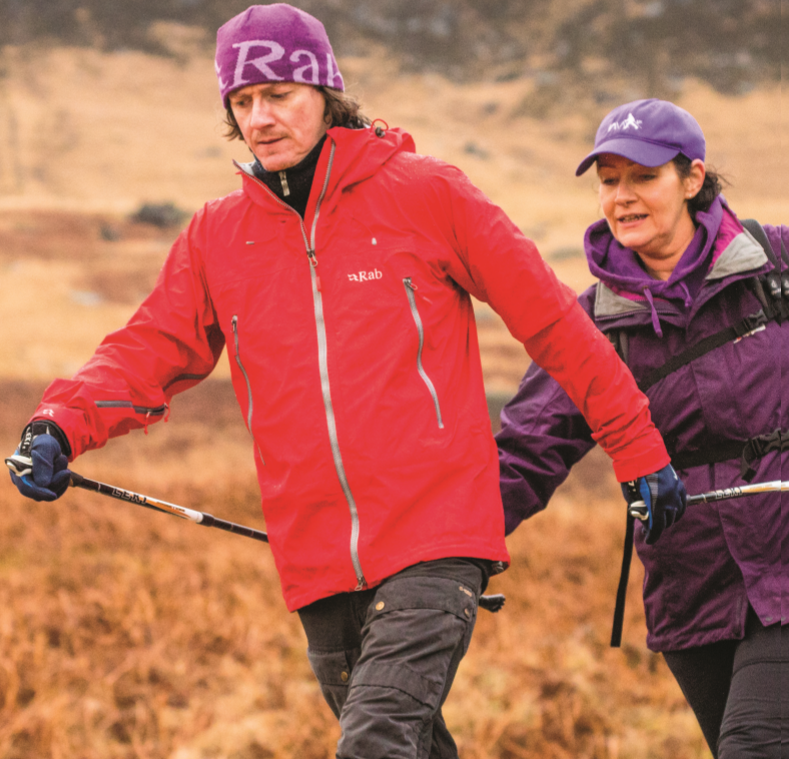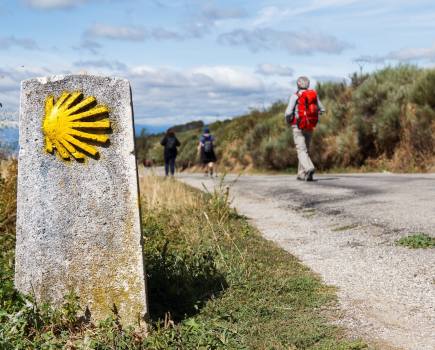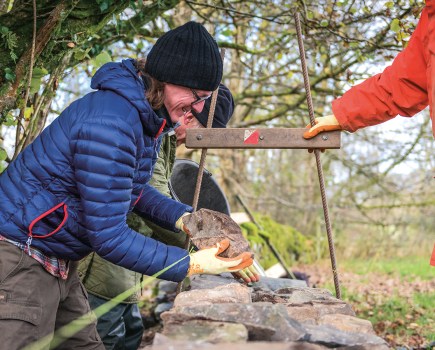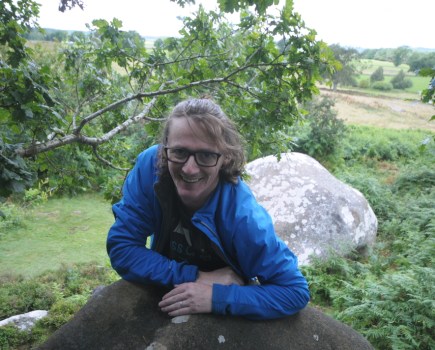It’s the world’s fastest growing fitness activity – but could a day out with a Nordic Walking instructor be enough to persuade Ed to try walking with poles?
For a long time, I’ve been a big fan of the Buff multifunctional headscarf. My hair tends to sit at a length that’s too short to tie into a ponytail but long enough that it tends to get in my eyes. For this reason, whenever I’m out walking I like to wear some sort of headgear to keep these luxurious locks that nature has bestowed upon me in check. Caps tend to blow off and woolly beanies are oft en too warm but a Buff is just the ticket.
The only problem with wearing a headscarf is that, while it might be acceptable on a mountain, back in the real world it has the effect of making one look like a bit of a tool. Not many people can carry off a headscarf unless they’re in a biker gang or an eighties metal band. For this reason, my Buff always used to mark the official transition between “normal life” and “going for a walk”. I would don my ludicrous headgear as soon as I got out of the car and then once I returned, aching but satisfied from the hill, I would toss it on the passenger seat before heading for home.
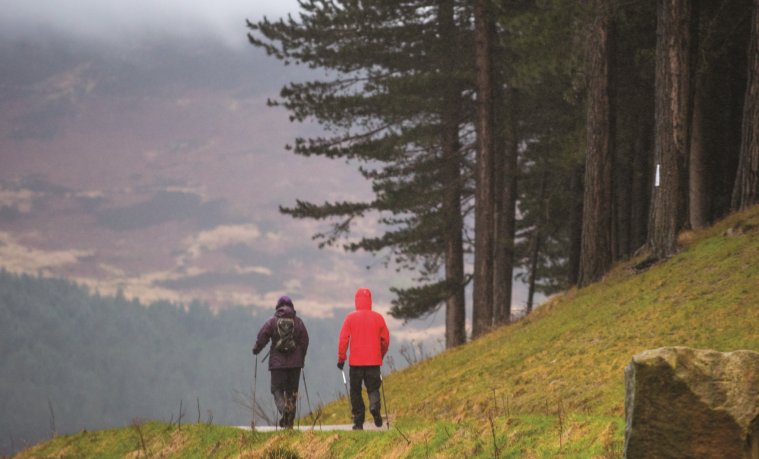
As time wore on, however, I became less precious about this transition and would wait until I had actually driven home before taking it off , allowing myself to be seen in motorway service stations still sporting the symbol of my outdoor excursions. Before long, much to my wife’s chagrin, I was wearing a Buff around the house, giving myself the look of a man recovering from brain surgery if I sported it with pyjamas. Since adopting a headscarf as loungewear it has become impossible to distinguish “mountain me” from “everyday me”. As a man in my forties I have no shame about wearing Berghaus to the shops. I’ll use my Osprey Talon backpack to carry snacks for the kids. My usual choice of footwear, if not walking boots, is usually a pair of trail shoes.
There really is no longer anything that marks a deliniation between me merely “walking around” and me “going hiking”. That is because I don’t use trekking poles. Surely, if there is an item of equipment that distinguishes someone who is walking as a pastime from someone simply on their way somewhere, it is the pole. No matter how much down and Gore-Tex you rig yourself out in as a matter of course, nobody pops to the shops with a pair of Lekis in their hands. Short of ice axes and crampons, they are the greatest signifier that the user is going for a proper walk.
I never really got on with trekking poles. I’ve tried them but found little benefit for the trade-off of no longer having my hands free. I like the idea of protecting my knees from strain and spreading the load to all my limbs but I always felt rather ungainly when I used them. That, I was told by pole-using zealots, was because I wasn’t using them properly. I always found this notion a tad patronising. It’s a pair of sticks, not a set of bagpipes. How hard can they be to use properly?
I decided to find out, so I recruited the help of Nordic Walking instructor, Caroline Fisher. Caroline has been working as a fitness instructor and personal trainer for quite a while but for the last couple of years has focused more and more on Nordic Walking as it has increased dramatically in popularity. If she couldn’t help me get to grips with walking with poles, then nobody can. However, the first thing I learnt was that Nordic Walking poles are not the same as trekking poles. With Nordic poles you wear a special glove-like harness on your hand and wrist that clips into a lock on the top of the pole. This means you are attached to your pole in such a way that you can put a lot of weight on it without really having to grip it. As a piece of specialist kit, I thought it rather nifty.
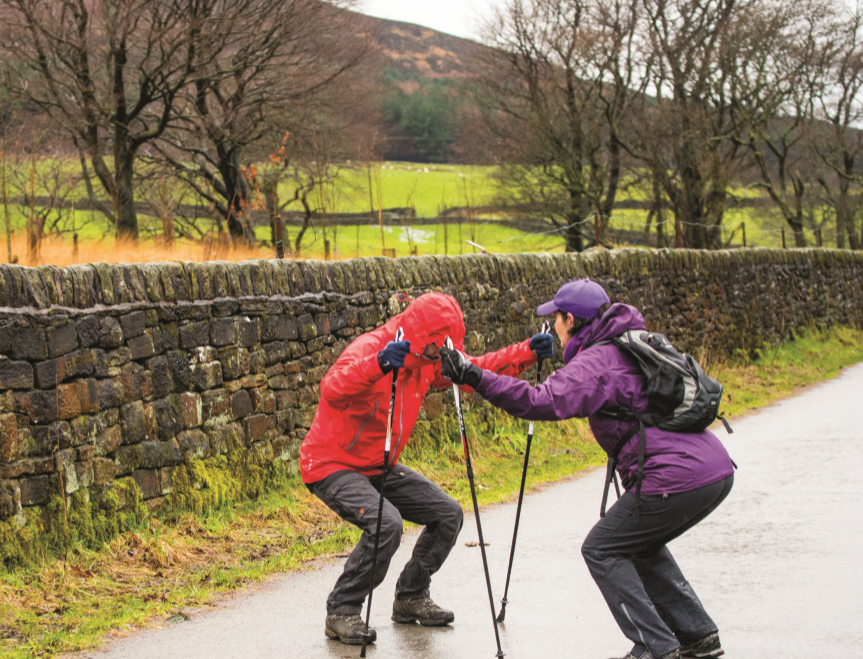
The pole customisation didn’t stop there. At the other end of the stick Caroline attached a far more ergonomic tip than I’d seen before. Rather than just a simple rubber bung, this thing looked like a tiny thick-soled boot. Like something a leprechaun would wear if it were to join a glam rock band. This, Caroline assured me, would give me some extra traction, particularly going uphill. My lesson began with some basic instruction regarding how straight/bent my arms should be and how far forward and back they needed to swing.
This information was less obvious than you might expect and demonstrated the truth in the notion that previously, I hadn’t been using poles properly. Caroline told me that to become proficient at Nordic Walking took about four hours of instruction spread over multiple lessons. I found this surprising. Even though I was already learning things I didn’t know, I still found it hard to understand why it would take up to four hours to get to grips with the technique. I would realise why soon enough.
We set off at a medium-to-brisk pace along the path that leads around Dovestone Reservoir on Saddleworth Moor. Caroline complimented me on my rhythm and how quickly I seemed to be picking up the technique. For my own part I was finding it less awkward than I had prior to the tips Caroline gave me but I wasn’t really feeling the benefit. That was until we got to an uphill section. In order to demonstrate how much energy I was transferring to my arms, Caroline had me walk up the hill and then, halfway up, stop using the poles. Immediately, the comparative strain on my legs was palpable and I suddenly realised what using poles was all about. They turn you from a biped into a quadriped. I know that seems obvious, a bit like saying “Gloves really keep your hands warm,” but this was the first time I could genuinely feel it. As we progressed around the reservoir, Caroline told me how Nordic Walking has been gaining popularity lately as an alternative to jogging or aerobics. She regularly leads groups of 15 or more mainly female walkers around the reservoir of a morning. I could just imagine the sight of 15 lycra-clad, quadripedal women powering their way around Dovestones like something out of Mad Max: Fury Road. She concurred that it was quite a formidable thing to witness.
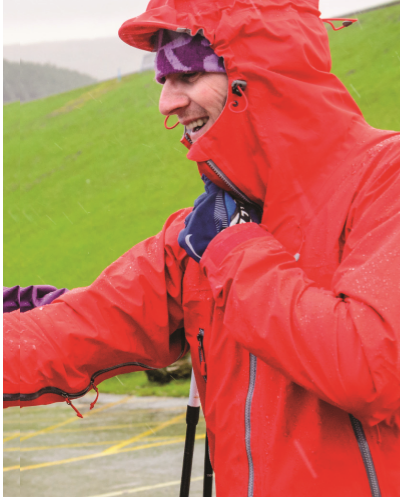
Basics covered, it was time to take it up a gear and break into a bit of a trot. You’d think that once you had the rhythm sorted, going a bit faster wouldn’t be an issue. You’d think wrong. As soon as I sped up, and my feet started leaving the ground, the poles began to flop about awkwardly and I became as ungainly as a newborn foal. Suddenly I appreciated how it could take four hours or more to really get the hang of this. We slowed it down again and Caroline got behind me for a bit of instruction reminiscent of the pottery scene in the movie Ghost. At Caroline’s behest I relaxed my arms while she, if you’ll pardon the expression, worked my pole for me. Following this refresher, we picked up the pace again, this time with more success.
As we increased speed I could see what the Scandinavians were onto with this. It’s a very good “all body” work-out. Caroline tells me that it can also, using a slightly different technique, be an excellent way to get into shape before going skiing. In my time with Caroline I feel I only scratched the surface of what Nordic Walking has to offer. For a few days afterwards I felt that satisfying stiffness in my arms and back, and even my abs, that tell you you’ve done something constructive.
Nordic Walking poles are now on my shopping list and I hope to make use of them in the future. As to whether I’m ready to join a platoon of power-walking Amazonians for an early morning workout, of that I’m not so sure.
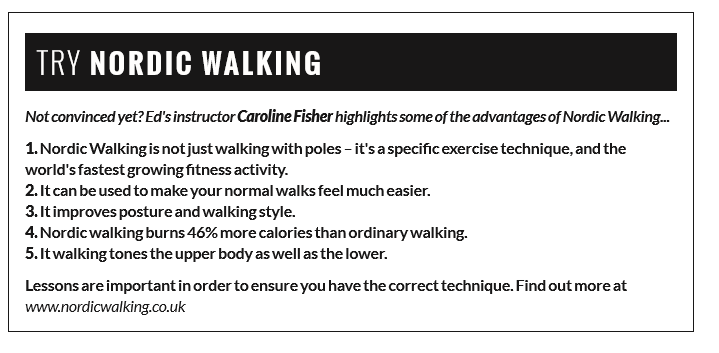
Photography: Jon Sparks

